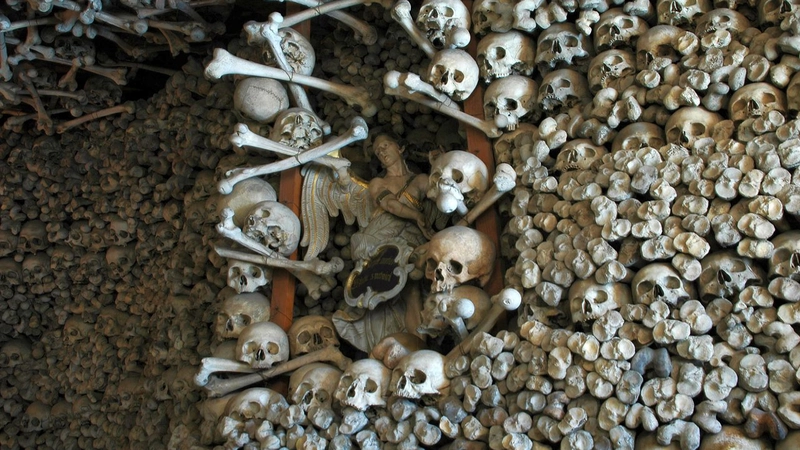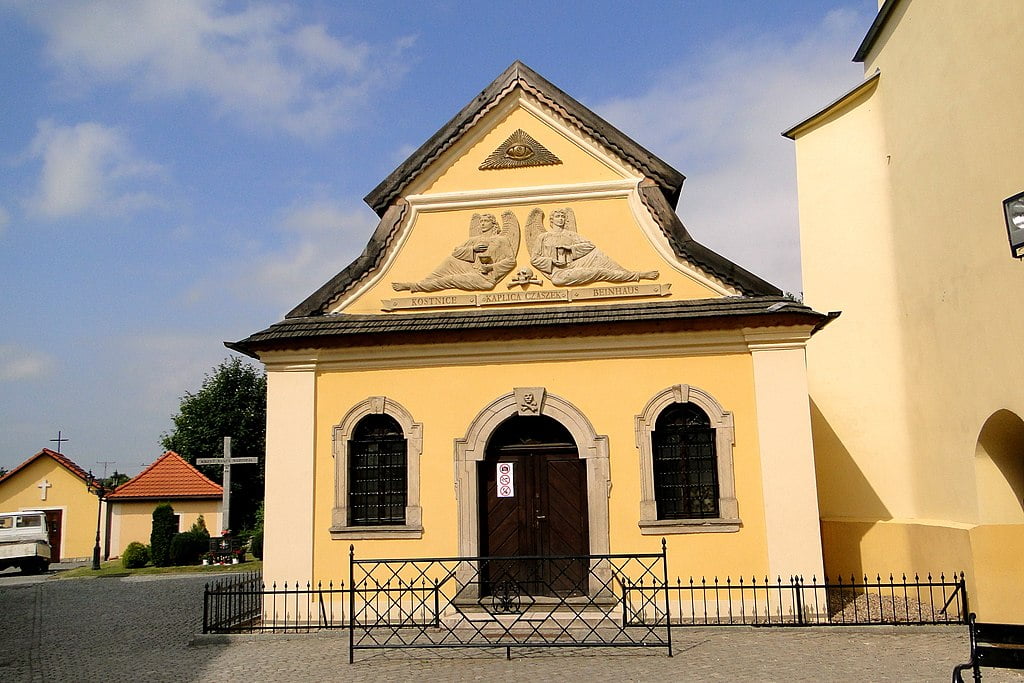
Located in the picturesque village of Czermna in southwestern Poland, the Skull Chapel is an eerie yet fascinating place that attracts curious visitors from all over the world. When you step inside this small chapel, you will find yourself among the bones of thousands of people. Whatever your interpretation, one thing is certain. The Skull Chapel is a unique and unforgettable destination that will leave a lasting impression on anyone who visits it.
Geographic Location
| Czermna Czermna is a small village in southwestern Poland. It is situated approximately 130 kilometers from Wroclaw, 150 kilometers from Prague (Czechia) and 230 kilometers from Dresden (Germany). |
The Skull Chapel (Kaplica Czaszek) in Czermna is located in the southwest of Poland, near the border with Czechia. Specifically, the chapel is situated a few kilometers from the border, making it a destination that is easily accessible from both Poland and Czechia. The chapel is located in the Lower Silesia, which is known for its rich cultural heritage and picturesque landscape. The region is home to several other significant cultural sites, such as historic monasteries and castles, which are all within a reasonable driving distance from the Skull Chapel.
The Skull Chapel’s location in Lower Silesia is a significant factor in its cultural and historical significance. The region has been inhabited for centuries and has been the site of many important events throughout history. It has been shaped by a variety of influences, including German, Czech and Polish cultures, which have left their mark on the region’s architecture, art and traditions. The Skull Chapel is a prime example of this cultural diversity and serves as a testament to the region’s rich and varied history.
The History of the Skull Chapel
The history of the Skull Chapel is shrouded in mystery and speculation. While some historians and researchers have proposed a clear and concise narrative of its origins, others remain skeptical of these accounts, and propose alternative theories regarding the origins and purpose of the chapel. One of the prevailing ideas regarding the Skull Chapel’s origins is that it was established in the 18th century by a local priest named Václav Tomášek, who drew inspiration from the Capuchin Crypt in Rome. According to this notion, Tomášek gathered human skulls and bones from nearby cemeteries and arranged them in the chapel as a means of prompting his congregation to contemplate the fleeting nature of existence and the inescapability of death.
However, other researchers have disputed this theory, citing discrepancies in the historical record and the lack of clear evidence linking Tomášek to the creation of the chapel. Some have proposed alternative theories, such as the possibility that the chapel was created as a way to commemorate fallen soldiers or victims of epidemics, or that it was a form of artistic expression or religious devotion.
One particularly intriguing theory suggests that the chapel was created as part of a secret society or cult, which practiced esoteric rituals and believed in the power of human remains to harness supernatural forces.
Late Modern Period
Throughout the 19th century, the chapel remained mostly unaltered. Many writers and travelers visited the site during this time, documenting their experiences and contributing to the increasing knowledge of the chapel’s past and importance.
In the early 20th century, several organizations and individuals undertook various restoration and renovation projects to ensure the preservation of the Skull Chapel for future generations. Despite these efforts, the chapel suffered neglect during the Second World War due to the German occupation of Poland and the resultant disregard for cultural landmarks and monuments.
After the war ended in 1945, a group of volunteers restored the Skull Chapel to its former glory, ensuring that it would continue to be an essential cultural and religious site in Poland.
Where did the Bones Come from?
The origins of the bones in the Skull Chapel have been a subject of debate and speculation for centuries. Historians and scholars have proposed various theories, but some historical events may provide clues, such as the Thirty Years’ War. This significant conflict took place in Central Europe from 1618 to 1648, resulting in extensive destruction, mainly in Germany and Bohemia. The conflict started as a religious war between Catholics and Protestants but quickly evolved into a more complicated struggle for political and territorial control. The war left a trail of devastation and atrocities, with numerous massacres, looting, and the destruction of countless villages and towns. Millions of people lost their lives during the war or from famine and disease related to the conflict.
The Skull Chapel is located in what was once part of the Habsburg Empire, a region heavily impacted by the Thirty Years’ War. It is possible that some of the bones in the chapel were collected during or after the war, during the fighting, or as part of the widespread looting and destruction that occurred during the conflict. However, it is challenging to verify this theory as the bones in the chapel have not been definitively dated.
Another possibility for the origin of the bones is that they were obtained from local cemeteries and ossuaries during the 18th century. Due to the limited space in cemeteries, it was common practice at that time to reuse burial sites. It is plausible that the bones in the Skull Chapel were collected from nearby cemeteries in the late 1700s or early 1800s.
In addition to these theories, there is also the possibility that the bones were collected from victims of the plague, which swept through Europe multiple times throughout history. While this theory has not been widely discussed in relation to the Skull Chapel specifically, it is possible that some of the bones were collected from plague victims during outbreaks in the region.
Decoration and Architectural Features of the Chapel
The Skull Chapel is a unique structure that has garnered attention from historians, architects and tourists alike. It is widely regarded as one of the best examples of Baroque architecture in the region, with intricate designs and details that are intended to awe and shock visitors.

The chapel is a small, single-nave structure, measuring only 11 meters in length and 6 meters in width. However, despite its modest size, it is home to an estimated 3,000 skulls and tens of thousands of bones that have been arranged in intricate patterns and designs.
Despite its small size, the Skull Chapel is an impressive feat of architectural design. The intricate details and ornate designs of the chapel are a testament to the skill and creativity of the artisans who constructed it. The use of human bones in the design of the chapel is a particularly unique feature, and one that has garnered attention from historians and architects alike.

Photo: Merlin (Wikimedia) ©️CC BY 3.0
One of the most striking aspects of the chapel’s Baroque design is its use of light and shadow. The chapel’s walls are painted in a pale, off-white color, which serves as a backdrop for the intricate patterns and designs that are created by the arrangement of the bones. The use of light and shadow helps to emphasize the intricate details of the chapel’s decoration, creating a dramatic and awe-inspiring effect.
How to Get to the Skull Chapel?
The chapel is located in a small village called Czermna, which is approximately 8 kilometers from the town of Kudowa-Zdrój. The easiest way to reach the chapel is by car. Visitors can rent a car from nearby towns and drive to the chapel. There is a small parking lot near the chapel for visitors to park their cars.
Alternatively, visitors can take a bus to Czermna from Kudowa-Zdrój. The bus journey takes around 20 minutes, and there is a bus stop near the chapel. However, the bus service is not very frequent, and visitors may need to plan their trip accordingly.
Another option is to take a taxi from Kudowa-Zdrój or Wrocław directly to the chapel. This option is more expensive than taking a bus but provides more flexibility in terms of timing.
For those coming from abroad, the closest airport to Czermna is the airport in Wrocław, approximately 125 kilometers away.
- Kaplica Czaszek w Kudowie Czermnej, Kudowa Zdrój, (kudowa-info.pl)



